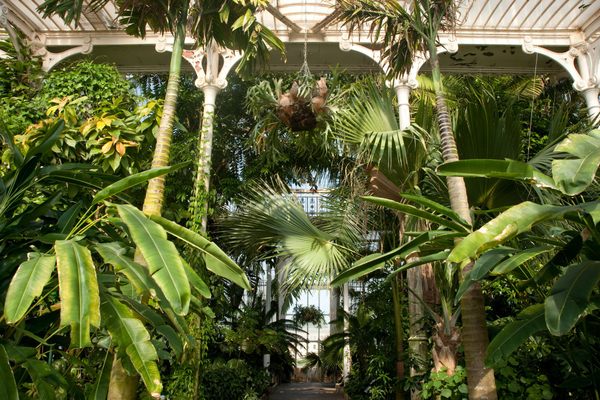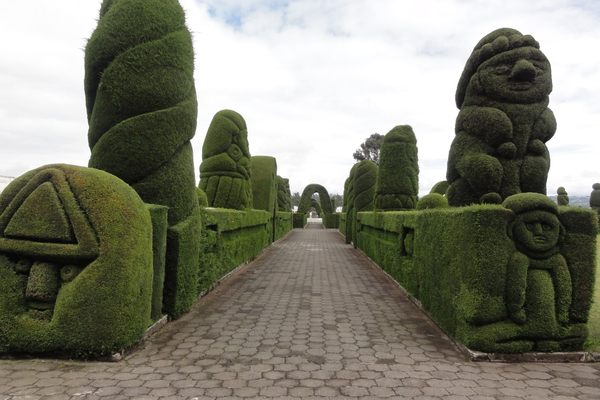Watching the Strange & Stinky Corpse Flower Bloom
The Corpse Flower (photograph by Kate Lain, courtesy the Huntington Library, Art Collections, & Botanical Gardens)
“Nature has its own clock.”
After nearly a week of watching, waiting, and preparing for the bloom of the Amorphophallus titanum, or less delicately known as the “Corpse Flower,” this truth spoken by Huntington Garden docent Nancy Howard couldn’t have been more apt. At approximately 3:01 pm on Saturday, August 23, an announcement was made at the Huntington Conservatory in San Marino, California. The world’s largest flower had begun its beautiful, short, and stinky life.
Inside the Corpse Flower (photograph by Erin Johnson)

The Amorphophallus titanum, shorten to Titan Arum, is a rare tropical plant native to the Indonesian rainforests of Sumatra. It has been known to grow up to eight feet tall and four feet diameter, earning the distinction as world’s largest flower. The irony, of course, that it isn’t actually a flower. It’s a inflorescence, meaning it’s made up of hundreds of tiny flowers inside the base of the stem.
The Titan Arum has two visible parts: the spadix and the spathe. The spadix is a fleshy upright column that sort of resembles a cactus without needles. This part of the plant, if reaches its maximum height, can grow to be taller than Shaq (who is seven foot one inch). The spathe is the petal-like outer covering. Green on the outside, like a corn stalk, but when the plant opens up during bloom, the distinct purple, maroon color of the inside reveals itself to the world. It’s truly a gorgeous, unique, and intimidating plant. But what really grabs your attention is the smell.
Detail of the Corpse Flower (potograph by Kate Lain, courtesy the Huntington Library, Art Collections, & Botanical Gardens)
There is a reason we call it the “Corpse Flower.” The stench that this flora emits is similar to rotting flesh. The reason for the smell is to attract pollinators, and in its native habitat that is the sweat bee. When in bloom, the plant sends out this odor near and far to bring in the bees to help pollinate both this particular flower and others across the forest. Like nature is known to do, the Corpse Flower has its own unique way of ensuring its survival.
Monitoring the Corpse Flower (photograph by Kate Lain, courtesy the Huntington Library, Art Collections, & Botanical Gardens)
The short life cycle of the Corpse Flower only adds to its beauty. The plant can go many years without flowering. When it’s not in bloom, it produces a single “leaf.” Its many leaves (or leaflets) attached to a single stalk resembles a green palm tree, and can grow up to 12 feet tall. When the corm (the bulb-like tubular buried in the soil that the plant arises from) stores enough energy, a blooming occurs. The timetable associated for each plant can vary, and botanist still don’t have any sort of formula to figure out when an individual Corpse Flower will bloom. Quite simply, it just happens when nature feels like it.
The Huntington’s Corpse Flower (photograph by Kate Lain, courtesy the Huntington Library, Art Collections, & Botanical Gardens)
When the stalk of the Corpse Flower reaches a certain point, it becomes apparent to the trained eye that this is will either be a blooming flower, or not. If it is, the flower can grow up to six inches a day, a rate so fast that it can almost be seen with the naked eye.
Charting the Corpse Flower’s progress (photograph by Matt Blitz)
Eventually, growth slows down and the unfurling begins. It takes 12 hours for the flower to reach it’s full reveal (this is also when the stench is strongest). It stays fully bloomed for several hours, then takes another 12 hours to collapse upon itself and die. The entire lifespan of the Corpse Flower is 24 to 30 hours. For a flower that some botanists wait their entire lives to see, there is something poetic about it being with us for the entirety of one day.
Blooming Corpse Flower (photograph by Kate Lain, courtesy the Huntington Library, Art Collections, & Botanical Gardens)
This 2014 bloom at the Huntington Gardens has been, literally, 15 years in the making. In 1999, the Huntington had it’s first bloom of the Corpse Flower. Garnering national attention, “Big Stinker” was first the Corpse Flower to bloom in the state of California. During the short bloom, Huntington botanists hand-pollinated the plant with it’s own pollen, using an experimental technique that was far from a sure thing. It worked. Ten fertile seeds were produced. 2014’s “Stinky 5,” so-called because it’s the fifth Corpse Flower to bloom at the Huntington, is the progeny of the 1999 bloom.
Maintaining the Corpse Flower (photograph by Kate Lain, courtesy the Huntington Library, Art Collections, & Botanical Gardens)
With all of this in mind, Atlas Obscura had to pay a visit to Huntington Gardens on Saturday, August 23. And spend all day there. And come back Sunday. We even happened (when you are there all day, you help your chances) to be there when the official call was made, that our friend “Stinky 5” was blooming. The time was declared, 3:01 pm, and the waiting became watching. Over the next seven hours, the flower allowed us to see it in all of its glory. Even within 30 minutes, there was a noticeable change in the extension of the bloom. Crowds increased and excitement grew. There were audible gasps and children yelling, “I just saw it move!” A real sense of community arose, a collective knowing that we were all there for the same reason: to watch nature do its thing.
Corpse Flower fans (photograph by Kate Lain, courtesy the Huntington Library, Art Collections, & Botanical Gardens)
We had to come back Sunday morning to make sure we got a good whiff. And we did. At least to my nose, it didn’t quite smell like rotting flesh. Rather, I would describe it as having a well-used port-a-potty aroma. Or, perhaps, hot garbage. A lady next to me on Sunday exclaimed, “It smells like meat you threw away three days ago.” Yeah, maybe not corpse-like, but certainly not pleasant.
Extracting the essence of Corpse Flower (photograph by Kate Lain, courtesy the Huntington Library, Art Collections, & Botanical Gardens)
We were also able to see Huntington’s botanists take samples of a liquid they found within the flower, something that wasn’t done with the first Stinkies. There was thought it could be a nectar, but without running tests, they couldn’t be sure. They also pollinated the plant, this time using pollen from a Corpse Flower from Orange Coast College, to ensure we get a “Stinky 6.”
photograph by Erin Johnson
A thanks goes out to all the individuals at the Huntington Library, Art Collections, and Botanical Gardens for allowing us this chance to witness the Corpse Flower. Also big thanks to Huntington’s Tumblr aficionado Kate Lain, communications coordinator Lisa Blackburn, botanist Brandon Tam, botanist John Trager, and docent Nancy Howard for answering all of our questions and just generally being delightful.
photograph by Erin Johnson
Until next time, go explore and, remember, nature sets its own clock.
Read more about the Huntington Gardens Corpse Flower at their site.












Follow us on Twitter to get the latest on the world's hidden wonders.
Like us on Facebook to get the latest on the world's hidden wonders.
Follow us on Twitter Like us on Facebook